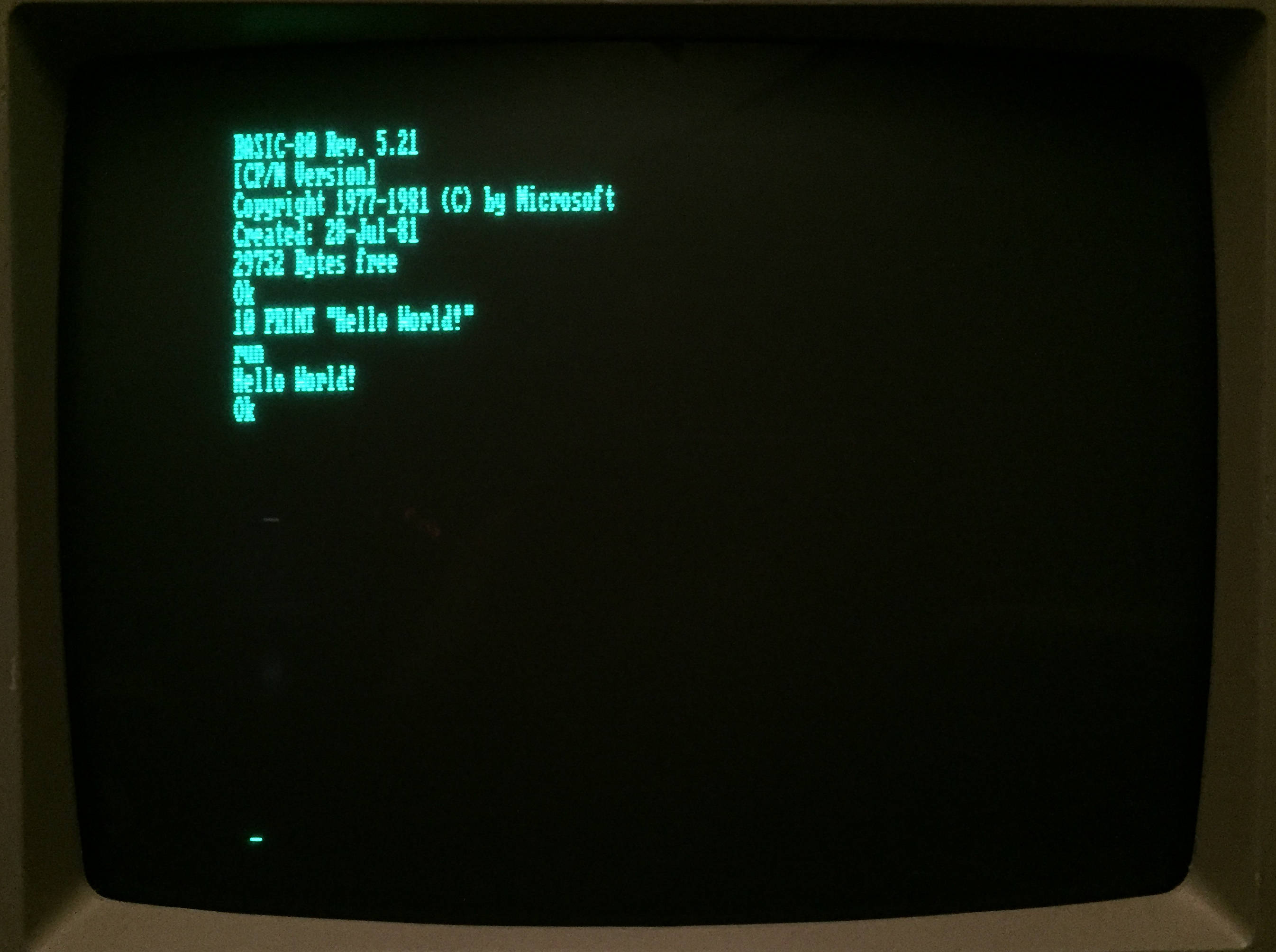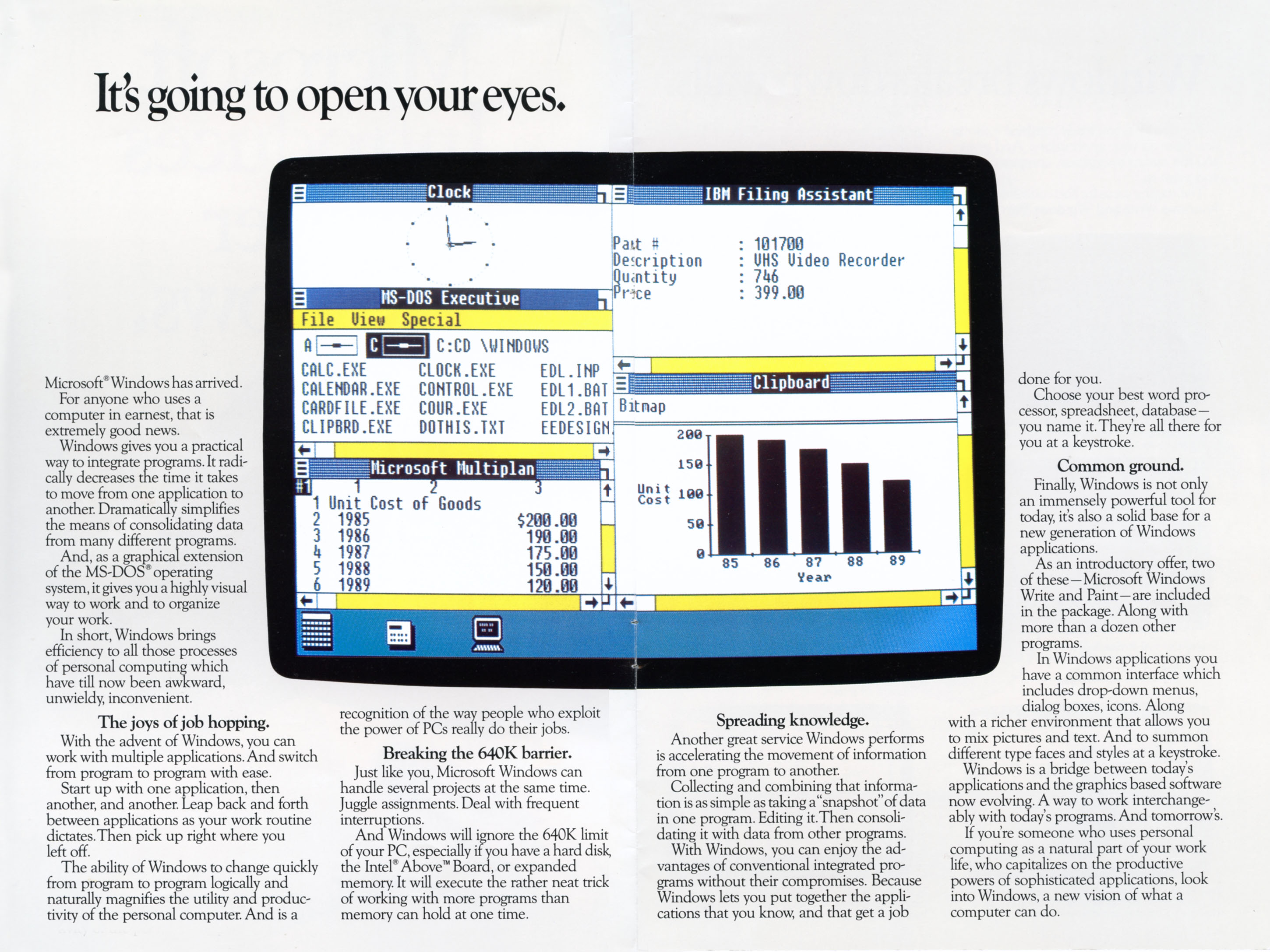|
MBASIC
MBASIC is the Microsoft BASIC, Microsoft BASIC implementation of BASIC for the CP/M operating system. MBASIC is a descendant of the original Altair BASIC interpreters that were among Microsoft's first products. MBASIC was one of the two versions of BASIC bundled with the Osborne 1 computer. The name "MBASIC" is derived from the disk file name MBASIC.COM of the BASIC interpreter. MBASIC, like its predecessor family of 8-bit interpreters Microsoft BASIC, were heavily inspired by Digital Equipment Corporation PDP-10's BASIC-PLUS. Environment MBASIC version 5 required a CP/M system with at least 28 KB of random-access memory (RAM) and at least one diskette drive. Unlike versions of Microsoft BASIC-80 that were customized by home computer manufacturers to use the particular hardware features of the computer, MBASIC relied only on the CP/M operating system calls for all input and output. Only the CP/M console (screen and keyboard), line printer, and disk devices were available. ... [...More Info...] [...Related Items...] OR: [Wikipedia] [Google] [Baidu] |
Osborne 1
The Osborne 1 is the first commercially successful portable computer, released on April 3, 1981 by Osborne Computer Corporation. It weighs , cost US$1,795, and runs the CP/M 2.2 operating system. It is powered from a wall socket, as it has no on-board battery, but it is still classed as a portable device since it can be hand-carried when the keyboard is closed. The computer shipped with a large bundle of software that was almost equivalent in value to the machine itself, a practice adopted by other CP/M computer vendors. Competitors quickly appeared, such as the Kaypro II. History The Osborne 1 was developed by Adam Osborne and designed by Lee Felsenstein, first announced in early 1981. Osborne, an author of computer books decided that he wanted to break the price of computers. The computer's design was based largely on the Xerox NoteTaker, a prototype developed at Xerox PARC in 1976 by Alan Kay. It was designed to be portable, with a rugged ABS plastic case and a handle ... [...More Info...] [...Related Items...] OR: [Wikipedia] [Google] [Baidu] |
Microsoft BASIC
Microsoft BASIC is the foundation software product of the Microsoft company and evolved into a line of BASIC interpreters and compiler(s) adapted for many different microcomputers. It first appeared in 1975 as Altair BASIC, which was the first version of BASIC published by Microsoft as well as the first high-level programming language available for the Altair 8800 microcomputer. During the home computer craze of the late-1970s and early-1980s, Microsoft BASIC was ported to and supplied with many home computer designs. Slight variations to add support for machine-specific functions, especially graphics, led to a profusion of related designs like Commodore BASIC and Atari Microsoft BASIC. As the early home computers gave way to newer designs like the IBM Personal Computer and Macintosh, BASIC was no longer as widely used, although it retained a strong following. The release of Visual Basic rebooted its popularity and it remains in wide use on Microsoft Windows platforms in its m ... [...More Info...] [...Related Items...] OR: [Wikipedia] [Google] [Baidu] |
CP/M
CP/M, originally standing for Control Program/Monitor and later Control Program for Microcomputers, is a mass-market operating system created in 1974 for Intel 8080/Intel 8085, 85-based microcomputers by Gary Kildall of Digital Research, Digital Research, Inc. CP/M is a disk operating system and its purpose is to organize files on a magnetic storage medium, and to load and run programs stored on a disk. Initially confined to single-tasking on 8-bit processors and no more than 64 kilobytes of memory, later versions of CP/M added multi-user variations and were migrated to 16-bit processors. CP/M's core components are the ''Basic Input/Output System'' (BIOS), the ''Basic Disk Operating System'' (BDOS), and the ''Console Command Processor'' (CCP). The BIOS consists of drivers that deal with devices and system hardware. The BDOS implements the file system and provides system services to applications. The CCP is the command-line interpreter and provides some built-in commands. CP ... [...More Info...] [...Related Items...] OR: [Wikipedia] [Google] [Baidu] |
Microsoft
Microsoft Corporation is an American multinational corporation and technology company, technology conglomerate headquartered in Redmond, Washington. Founded in 1975, the company became influential in the History of personal computers#The early 1980s and home computers, rise of personal computers through software like Windows, and the company has since expanded to Internet services, cloud computing, video gaming and other fields. Microsoft is the List of the largest software companies, largest software maker, one of the Trillion-dollar company, most valuable public U.S. companies, and one of the List of most valuable brands, most valuable brands globally. Microsoft was founded by Bill Gates and Paul Allen to develop and sell BASIC interpreters for the Altair 8800. It rose to dominate the personal computer operating system market with MS-DOS in the mid-1980s, followed by Windows. During the 41 years from 1980 to 2021 Microsoft released 9 versions of MS-DOS with a median frequen ... [...More Info...] [...Related Items...] OR: [Wikipedia] [Google] [Baidu] |
Data Compression
In information theory, data compression, source coding, or bit-rate reduction is the process of encoding information using fewer bits than the original representation. Any particular compression is either lossy or lossless. Lossless compression reduces bits by identifying and eliminating statistical redundancy. No information is lost in lossless compression. Lossy compression reduces bits by removing unnecessary or less important information. Typically, a device that performs data compression is referred to as an encoder, and one that performs the reversal of the process (decompression) as a decoder. The process of reducing the size of a data file is often referred to as data compression. In the context of data transmission, it is called source coding: encoding is done at the source of the data before it is stored or transmitted. Source coding should not be confused with channel coding, for error detection and correction or line coding, the means for mapping data onto a sig ... [...More Info...] [...Related Items...] OR: [Wikipedia] [Google] [Baidu] |
ASCII
ASCII ( ), an acronym for American Standard Code for Information Interchange, is a character encoding standard for representing a particular set of 95 (English language focused) printable character, printable and 33 control character, control characters a total of 128 code points. The set of available punctuation had significant impact on the syntax of computer languages and text markup. ASCII hugely influenced the design of character sets used by modern computers; for example, the first 128 code points of Unicode are the same as ASCII. ASCII encodes each code-point as a value from 0 to 127 storable as a seven-bit integer. Ninety-five code-points are printable, including digits ''0'' to ''9'', lowercase letters ''a'' to ''z'', uppercase letters ''A'' to ''Z'', and commonly used punctuation symbols. For example, the letter is represented as 105 (decimal). Also, ASCII specifies 33 non-printing control codes which originated with ; most of which are now obsolete. The control cha ... [...More Info...] [...Related Items...] OR: [Wikipedia] [Google] [Baidu] |
GOSUB
Basic or BASIC may refer to: Science and technology * BASIC, a computer programming language * Basic (chemistry), having the properties of a base * Basic access authentication, in HTTP Entertainment * Basic (film), ''Basic'' (film), a 2003 film * Basic, one of the Galactic Basic, languages in ''Star Wars'' Music * Basic (Glen Campbell album), ''Basic'' (Glen Campbell album), 1978 * Basic (Robert Quine and Fred Maher album), ''Basic'' (Robert Quine and Fred Maher album), 1984 * B.A.S.I.C. (Alpinestars album), ''B.A.S.I.C.'' (Alpinestars album), 2000 * Basic (Brown Eyed Girls album), ''Basic'' (Brown Eyed Girls album), 2015 * B.A.S.I.C. (The Basics album), ''B.A.S.I.C.'' (The Basics album), 2019 Places * Basic, Mississippi, a community in the US * BASIC countries, Brazil, South Africa, India and China in climate change negotiations Organizations * BASIC Bank Limited, government owned bank in Bangladesh * Basic Books, an American publisher Other uses * Basic (cigarette), a brand ... [...More Info...] [...Related Items...] OR: [Wikipedia] [Google] [Baidu] |
Variable (computer Science)
In computer programming, a variable is an abstract storage location paired with an associated symbolic name, which contains some known or unknown quantity of data or object referred to as a '' value''; or in simpler terms, a variable is a named container for a particular set of bits or type of data (like integer, float, string, etc...). A variable can eventually be associated with or identified by a memory address. The variable name is the usual way to reference the stored value, in addition to referring to the variable itself, depending on the context. This separation of name and content allows the name to be used independently of the exact information it represents. The identifier in computer source code can be bound to a value during run time, and the value of the variable may thus change during the course of program execution. Variables in programming may not directly correspond to the concept of variables in mathematics. The latter is abstract, having no reference ... [...More Info...] [...Related Items...] OR: [Wikipedia] [Google] [Baidu] |
Computer Terminal
A computer terminal is an electronic or electromechanical hardware device that can be used for entering data into, and transcribing data from, a computer or a computing system. Most early computers only had a front panel to input or display bits and had to be connected to a terminal to print or input text through a keyboard. Teleprinters were used as early-day hard-copy terminals and predated the use of a computer screen by decades. The computer would typically transmit a line of data which would be printed on paper, and accept a line of data from a keyboard over a serial or other interface. Starting in the mid-1970s with microcomputers such as the Sphere 1, Sol-20, and Apple I, display circuitry and keyboards began to be integrated into personal and workstation computer systems, with the computer handling character generation and outputting to a CRT display such as a computer monitor or, sometimes, a consumer TV, but most larger computers continued to require terminal ... [...More Info...] [...Related Items...] OR: [Wikipedia] [Google] [Baidu] |




